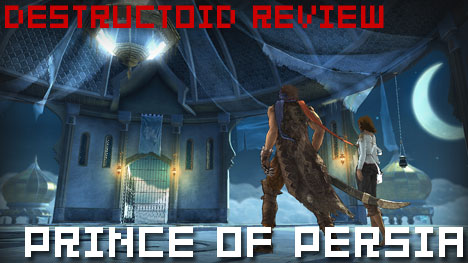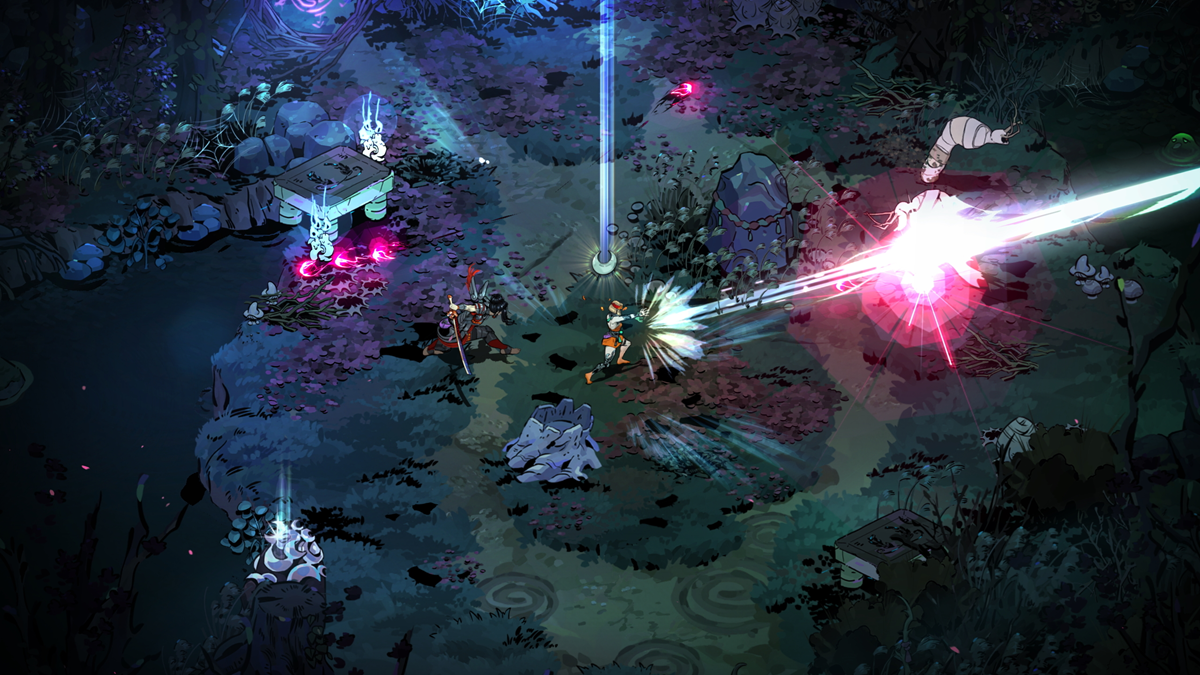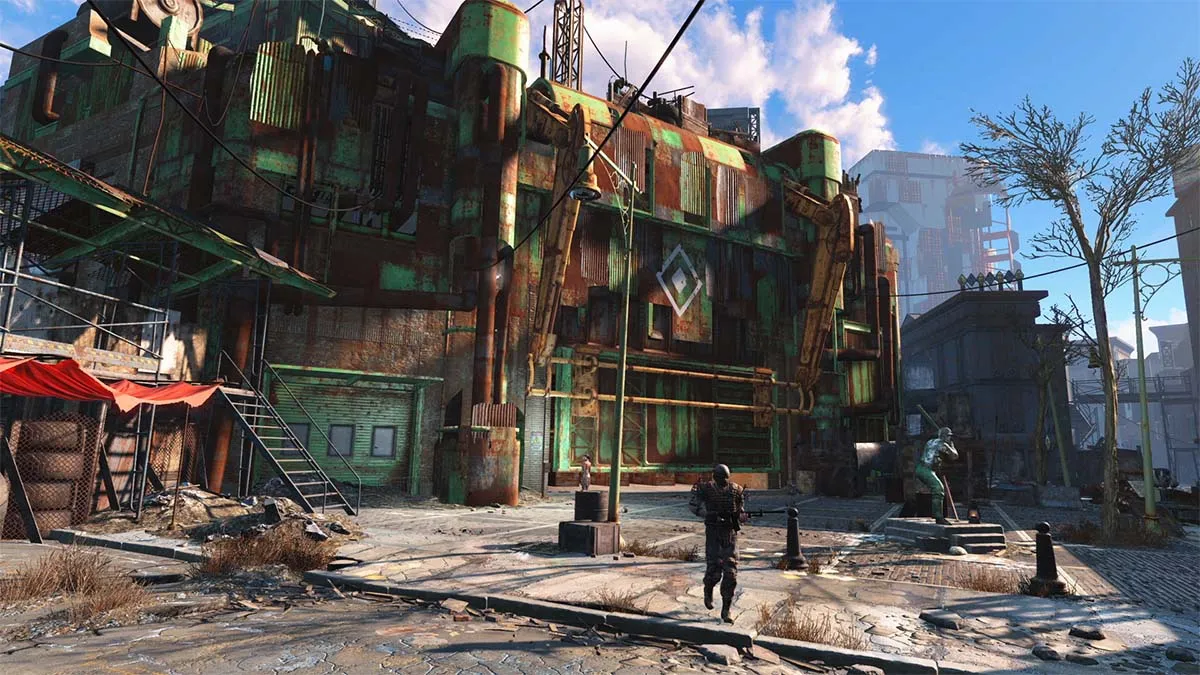Before you read this review, know this — I am a huge fan of Ubisoft’s Prince of Persia: The Sands of Time.
And if you’re a fan of that game as well, you and I are probably a lot alike. I was less thrilled with Warrior Within, disliking the tone, but loving the expanded, visceral combat. Two Thrones got the trilogy on track a bit, but was still missing that certain “something” that made Sands of Time so unique and special.
So I understand that you might be wary of yet another Prince of Persia series reboot, a fresh start for a new generation. I get it. So imagine my surprise that as the credits rolled for me on Prince of Persia, something pretty spectacular happened — I realized I enjoyed this game more than The Sands of Time.
I know — I’m shocked, too. Hit the jump for the full review.
Prince of Persia (Xbox 360, PlayStation 3 [reviewed], PC)
Developed by Ubisoft Montreal
Published by Ubisoft
Released on December 2, 2008 (US)
From a narrative standpoint, Prince of Persia takes everything you already knew about the series and pretty much tosses it out the window. This is a wholly new adventure, set in an entirely new world, with little to no narrative references to previous titles. If there’s any connection, it’s only thematically. And outside of an early reference to The Sands of Time — the story begins with our new Prince looking for a donkey he calls “Farah,” an obvious wink to the previous trilogy’s female lead — this game truly stands on its own in nearly every way.
For purists, this may seem like an odd and scary choice.
In fact, the new Prince of Persia not only sheds the narrative of its predecessors, but in many ways, reality itself. If you’re expecting Prince of Persia to take place in a typical or real-world Middle Eastern locale, you might be disappointed, as Ubisoft has painted (almost literally) its own reality, a lush, magical and fantastic one that makes it impossible to place the game anywhere on a timeline or anywhere in the world as we know it. It was a huge gamble, but it pays off; in doing so, Ubisoft have created a fantasy rooted in Persian mythology that ranks among the lore of gaming’s most significant and revered tales.
The story begins with a “The Prince,” a drifter who gets stuck in a sandstorm, which leads him to a chance meeting with Elika, a princess with a mysterious past. Already caught up in some dangerous business of her own, Elika pulls the Prince into her own adventurous tale. One things leads to another and Elika’s father destroys the Tree of Life, freeing the God of Darkness, Ahriman. This act corrupts the lands, bringing darkness to the once thriving City of Light. Feeling a great responsibility, Elika feels compelled to make things right by reaching the fertile grounds scattered across the land, and bringing life and color back to the world.

And this right here is what you’ll be doing for the next 10 to 15 hours of gameplay, traversing the game’s beautiful environments and battling bosses in close-encounter, individually-wrapped duels. From the outset, the world is open for you to explore. And while this isn’t a sandbox game per se (the story itself is rather linear), you are given options as to what order you’ll be tackling the world. From the start, all four of the game’s areas are open to you, linked by a central desert and temple hub. Not every inch of it will be accessible from the outset, however. It’s up to you to explore, cleanse, and open up these different areas as you progress.
Fortunately, exploring the world is extraordinarily exhilarating — in part due to the game’s breathtaking visuals, but more so because of its simple, streamlined controls. Here’s the “love it or hate it” part of Prince of Persia: the platforming elements of the game have been simplified when compared to other games of its type, particularly the last-gen trilogy. When it comes to moving throughout the world, you’re really looking at using very few buttons — the analog stick will move the Prince, one button will jump, and the circle button will interact with objects like rings on walls to pull you forward or upward.
While that seems like standard fare, the beauty of this control system is how few buttons you’ll actually have to press to make the Prince perform grand, sweeping actions. To run along a wall, you simply run at it and press jump — the Prince will take care of the rest, sometimes even slightly “auto-correcting” his movement for a smooth landing. Climbing up the side of a wall is even easier, as the Prince will use his hand gauntlet to pull himself up to a ledge with no prompting from you. Initially, this leads to some problems, as veterans of the series (and other 3D platforming games) will want to hit that jump button a second time to scale the wall; instead, they’ll find themselves jumping backwards off the wall … not what they had in mind.

Because it’s so simple in its design, and Ubisoft have decided to cut out all manner of button presses that gamers already take as a given, some will find themselves struggling at first. Imagine that: a game that’s so streamlined and simple in its control design that you’ll have to unlearn certain behaviors. But breaking free of the shackles of pressing a single button three times to perform one smooth action doesn’t take long, and once you do, it’s incredibly liberating. Making the Prince move from one side of the world to the other is a joy; it feels fast and smooth, with areas brilliantly designed to allow you to flow with the environment rather than against it. The challenge here is in discovering paths, not in fighting with a control pad to scale a wall or simply jumping from one platform to another.
Prince of Persia producer Ben Mattes bet his job with Ubisoft that pairing The Prince with an in-game sidekick would never take away from the experience, that she would only be a positive. Mattes should not only keep his job, but Ubisoft might want to consider getting him a corner office with a view and a fancy executive parking spot — Elika not only never gets in your way, but she’s one of the most useful and likeable AI-controlled sidekicks in any videogame. Ever. While you’re more or less physically attached to her throughout the whole game, it’s just as easy to become emotionally connected. As the story progresses, the game will force dialogue through cut-scenes and passive conversations through gameplay. But you’re also given the option to interact with her by pressing L1 or L2, initiating conversation to learn more about Elika (and in some cases, The Prince), as well as the history of the lands.
But she’s not just there for first-rate conversation, as she’s indispensable throughout your quest. Being paired with a magical sidekick has a few perks, the least of which is that she acts as a double jump — if there’s a long chasm you’ll need to cross, pressing the “Elika button” will make her swoop in and swing you forward, giving you additional air. While that’s cool in and of itself (and kind of brilliant in that it somewhat legitimizes the idea of a “double jump” through its narrative), it gets better — Elika’s magic is going to save your ass whenever you’re in trouble. This next part is going to be a bit difficult for people to get past, but stay with me — Elika won’t let you die. Yes, in Prince of Persia, you can’t die. If you miss a jump and fall off a cliff, Elika will swoop in and whisk you to a safe platform.

Cue the moaning: “Well, if you can’t die, how can there be any challenge? That’s pretty stupid that you can’t lose.” But think of it for a second — in most games, missing a jump usually results in a black screen, a “game over” screen, a loading screen, or some other screen that you may or may not see hundreds of times before the credits roll. In Prince of Persia, this is simply replaced with Elika, who provides a quick and seamless way of bringing you back to a checkpoint when you make a mistake. In many areas, platforms that provide footing for the Prince and Elika act as the checkpoints; while these are sometimes close together, there are many areas where a great deal of platforming separates them. But because of Elika, the game never feels frustrating or tiring; instead, it actually encourages you to continue playing by eliminating any real break in the action. Elika even has a magical “compass” of sorts to guide you so that you’ll never get lost or feel stuck.
While the bulk of the game will be spent exploring, you’ll also be engaged in a fair amount of combat, all of which is presented in a close-encounter manner, one enemy at a time. When you encounter a single enemy, the Prince will take a fighting stance, drawing his sword in preparation for battle. Once combat begins, you can use a number of attacks, with one button assigned to each — sword attack, acrobatic action, a gauntlet/throw maneuver, and calling on Elika for a magic attack.
The game actually employs a pretty interesting and deep combo system, with a “tree” that can branch off in a number of different ways. For example, starting off with a gauntlet attack, you can toss your opponent into the air, which will start a “lift combo.” From there, you can call on Elika, draw your sword, perform an acrobatic action, or use your gauntlet again. Depending on what you choose, you can enter into another portion of the combo tree, extending your attack. In this way it’s possible to perform some pretty fancy-looking and devastating attacks, all of which have their own distinct animations.
There’s almost no real difference in how battling a “standard” corrupted enemy and a boss battle plays out, although most enemies have their own specific quick time event button cues that vary from pressing a single button to tapping it furiously to break free of a hold. If the Prince takes enough damage, an enemy will have a chance to “kill” him in a quick time event sequence. If you fail, Elika will once again swoop in and knock back your opponent right before death; the consequence for this will be the enemy regaining a fair amount of health. Again, this is a situation in which you can’t “lose,” only be punished; like the platforming, this keeps battles moving forward while still maintaining a sense of tension.

A few of the major battles will have you fighting across a few different areas, with platforming elements tossed in, or will force you to force an enemy to a ledge or a certain direction. And as you progress through the game, enemy difficulty ramps up, along with the number of time they’ll parry your attack or initiate a quick time event. In a few cases this can get repetitive, with battles lasting anywhere from five to fifteen minutes apiece (depending on your skill level). Despite this, the game does a great job of making each encounter feel important, and finally besting an opponent after a long struggle is quite rewarding.
The third element of the Prince of Persia formula is the puzzles, and while fans will be happy to hear that they are indeed sprinkled throughout the game, they might be disappointed that you could count the number of them on two hands. There isn’t a single box to push in Prince of Persia, no broken statues to move, and not a single mirror to re-direct light onto a shining gem. All of the game’s puzzles involve turning cranks, usually to move platforms, or, in one case, to redirect water in a garden. While a few are time-consuming and at least one or two are thought-provoking, none of them are particularly difficult, instead just offering a diversion from battling and platforming.
Prince of Persia truly is a thrill to play, and a game that simply must be experienced first-hand. The world is a pleasure to explore, with some of the most gorgeous and varied visuals seen in any game to date. What you see in the screens translates smoothly to movement, with trademark Prince of Persia animations that feel fluid and look real despite some impossible acrobatics. The illustrative style provides a unique, watercolor-book-come-to-life look that gives it a similar feel to cel-shaded titles like Clover’s Okami, but is quite distinct enough for it to stand on its own. Coupled with Inon Zur’s and Stuart Chatwood’s cinematic score, every turn in the Prince of Persia world evokes a sense of child-like wonder.

While they don’t mar the overall experience too much, there are some minor things that keep Prince of Persia from being “perfect.” For example, while the story and dialogue are well written and executed, the character of the Prince may leave you with a bad taste. While all of the dialogue is delivered believably and with skill, no one (particularly the Prince) sounds like they belong in this world. In fact, most of them could be from anywhere-America, with accents and speech patterns that don’t lend themselves to the game’s otherwise Persian feel. And on one hand, Elika is an extremely likable character, one that you will come to care about well before the game’s finale. On the other, the Prince can come off as a bit too bold, too arrogant, and too immature at times (at one point he jokes with Elika to stop staring at his ass when climbing a wall). While this gives his character room to grow in future titles (and I certainly do hope this story continues in the future), it can be a bit of an initial turn-off.
With Prince of Persia, the team at Ubisoft not only reached the bar they set for themselves with previous titles, but in many ways delivered a game that transcends expectations while setting a new standard for the series. Ubisoft has taken Prince of Persia in a wild new and magical direction, an enormously fun and gratifying game from beginning to end.
Sands of Time is held in such high regard by many gamers, myself included, and simply matching that experience is an enormous task in and of itself. The fact that Prince of Persia stands toe-to-toe with that giant is not only an incredible feat, but makes it one of the “must-play” games of 2008 and this generation.
Score: 9.5 — Superb (9s are a hallmark of excellence. There may be flaws, but they are negligible and won’t cause massive damage to what is a supreme title.)





